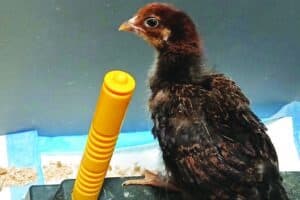Longtime local journalist Bill Radford and his wife, Margaret, live on 5 acres in the Falcon area with ducks, chickens, rabbits, dogs, cats, two noisy parrots, goats and a horse. Contact Bill at billradford3@gmail.com.
We wanted our cat Montana to be an indoor kitty.He, however, had other ideas. After a few inadvertent excursions outside, he must have decided he really liked it because he made it his goal in life to sneak out, waiting for us at the front door and racing out as soon as we opened it, or taking advantage of the few seconds that it takes for the back door to swing shut.So, he’s become an indoor/outdoor kitty. He always comes in at night; during the day, he seems to particularly enjoy going with us to the barn to feed the horse and goats. He doesn’t seem to stray beyond our property, other than dropping in on the feral cat colony managed by our neighbor Shirley. One of those feral cats has apparently decided our barn is the place to be, because we often find it there, along with another neighbor’s cat that is allowed to run free. Both of those cats, however, appear to head home every night.There are plenty of reasons to keep your cat confined inside, including the dangers posed by predators, disease, poisons and traffic. There is also the threat posed to wildlife, particularly birds, by free-roaming felines. So many rescue groups insist on keeping cats indoors; my mother, in recently adopting a cat, had to sign a statement that she would keep it inside.Ami Manivong, feline programs manager at the Humane Society of the Pikes Peak region, believes there is a place for all cats ñ- “social indoor cats, social indoor/outdoor cats, feral cats and so on.”Certainly, a cat that has lived indoors may not fare well if it is forced to become reliant on outdoor resources (food, shelter, warmth), Manivong said. “He is accustomed to his person feeding him at the same time every day and not hunting or rummaging for his food, napping on his cat tree all day and playing with fake mice. His senses are different; and, even though cats are savvy creatures, having to acclimate those senses to the outdoors may be a challenge.”On the flip side, a cat that is used to being an indoor/outdoor kitty and is suddenly forced to live strictly indoors may develop undesirable habits such as litter box issues or playing too rough, Manivong said. And some cats, such as feral cats, may not be suitable for the indoors at all.Through its Barn Cat Program, the Humane Society provides a place in the world – and a job – for those cats not suited to an indoor lifestyle. The program has three categories of cats: general adoption barn cats, feral barn cats and feisty barn cats.General adoption barn cats are cats known to have outdoor experience, with known hunting experience, and are generally good around people and other animals ñ- but those cats might not do well in an indoor-only environment. Feisty barn cats ñ- a new category ñ- are cats that are more social than feral cats but have shown feisty tendencies such as biting or not doing well with a lot of handling.Manivong said, îFor example, I had a cat here who had spent his entire life living indoor/outdoor, but his owner decided he needed to live inside because she moved into an apartment. He hated life -ñ he bit the kid, hated the dog, was house soiling, and was just miserable being forced to live inside. The owner herself said she knew he’d be happier if he could live outside again. Because of his aggression history I couldn’t place him for regular adoption, so I opted to go the barn cat route, and he was adopted. He loved attention – he just needed that outdoor outlet to hunt, do cat things; and he rebelled once he no longer had that.”Manivong said she takes great care in selecting candidates for barn cats. “I ensure the cats have outdoor history, are not declawed and are healthy and thriving.”As of mid-October, there had been 120 barn cat adoptions this year. In the past, many such cats would have been doomed.”Before programs like the Barn Cat Program, Trap-Neuter-Return and Shelter-Neuter-Return, the vast majority of feral or feisty cats weren’t adoption candidates and were euthanized because they simply weren’t adoptable,” Manivong said. “With programs like these becoming community standards across the country, these cats now have the chance to live out their lives.”To learn more about the Barn Cat Program, go to hsppr.org/springs/barn-cats.






